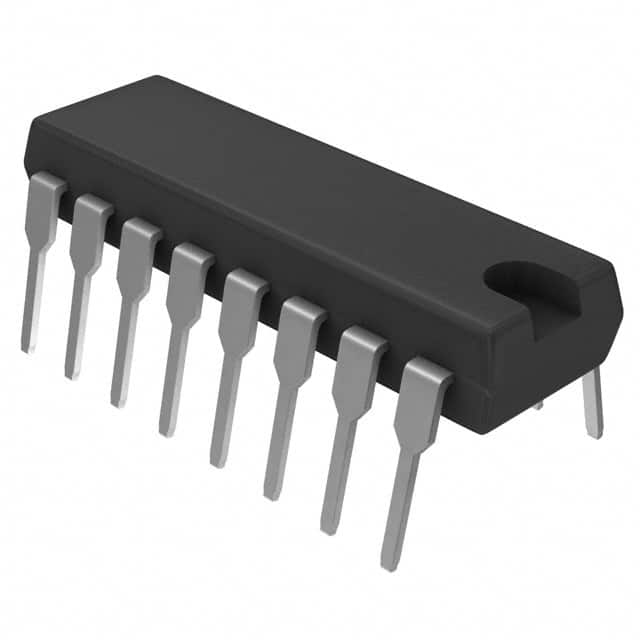Lihat spesifikasi untuk detail produk.

SN74HC4851N
Product Overview
- Category: Integrated Circuit
- Use: Analog Multiplexer/Demultiplexer
- Characteristics: High-Speed CMOS Logic, 8-Channel, Single-Ended or Differential Input
- Package: PDIP (Plastic Dual-In-Line Package)
- Essence: Analog Switches/Multiplexers/Demultiplexers
- Packaging/Quantity: Tube/40 pieces per tube
Specifications
- Supply Voltage Range: 2V to 6V
- On-State Resistance: 70Ω (Typical)
- On-State Resistance Flatness: 5Ω (Typical)
- Low Power Consumption: 80μA (Maximum)
- Wide Operating Temperature Range: -40°C to +85°C
- Input Signal Range: ±10V (Maximum)
Detailed Pin Configuration
The SN74HC4851N has a total of 16 pins. The pin configuration is as follows:
__ __
A0 |1 \__/ 16| VCC
A1 |2 15| S0
A2 |3 14| S1
A3 |4 13| S2
A4 |5 SN 12| S3
A5 |6 74 11| INH
A6 |7 HC 10| COM
A7 |8 4851 9| GND
----------
Functional Features
- 8-channel analog multiplexer/demultiplexer
- Single-ended or differential input capability
- Low power consumption
- Wide operating temperature range
- Fast switching speed
- Break-before-make switching action
- TTL-compatible control inputs
Advantages and Disadvantages
Advantages
- Versatile multiplexer/demultiplexer solution
- High-speed CMOS logic for fast switching
- Wide operating temperature range allows for use in various environments
- Low power consumption for energy efficiency
- Break-before-make switching action ensures signal integrity
Disadvantages
- Limited input signal range (±10V maximum)
- Only available in PDIP package, limiting space-constrained applications
Working Principles
The SN74HC4851N is an analog multiplexer/demultiplexer that allows the selection of one of eight input channels to be routed to a single output. It operates based on the control signals provided to the select inputs (S0-S3). The selected channel's input is connected to the common terminal (COM) and can be either single-ended or differential.
The device utilizes high-speed CMOS logic, enabling fast switching between channels. It features break-before-make switching action, ensuring that there is no overlap or short-circuiting during the transition between channels.
Detailed Application Field Plans
The SN74HC4851N finds applications in various fields, including:
- Audio/Video Switching: Used in audio/video equipment to select different input sources.
- Data Acquisition Systems: Enables multiplexing of analog signals in data acquisition systems.
- Communication Systems: Used for signal routing and switching in communication systems.
- Industrial Automation: Allows for channel selection in industrial automation processes.
- Test and Measurement Equipment: Utilized in test and measurement setups for signal routing.
Detailed and Complete Alternative Models
- CD4051B: 8-channel analog multiplexer/demultiplexer with similar characteristics.
- ADG508A: Precision CMOS analog multiplexer/demultiplexer with 8 channels.
- MAX4617: Low-voltage, single-supply analog multiplexer/demultiplexer with 8 channels.
These alternative models offer similar functionality and can be considered as alternatives to the SN74HC4851N.
Word count: 452 words
Sebutkan 10 pertanyaan dan jawaban umum terkait penerapan SN74HC4851N dalam solusi teknis
Sure! Here are 10 common questions and answers related to the application of SN74HC4851N in technical solutions:
Q1: What is SN74HC4851N? A1: SN74HC4851N is a multiplexer/demultiplexer IC (Integrated Circuit) that allows multiple analog or digital signals to be routed through a single channel.
Q2: What is the purpose of using SN74HC4851N? A2: The purpose of using SN74HC4851N is to simplify signal routing and reduce the number of required input/output pins on a microcontroller or other digital devices.
Q3: How many channels does SN74HC4851N have? A3: SN74HC4851N has 8 channels, which means it can handle up to 8 different signals.
Q4: Can SN74HC4851N handle both analog and digital signals? A4: Yes, SN74HC4851N can handle both analog and digital signals, making it versatile for various applications.
Q5: How do I select a specific channel using SN74HC4851N? A5: Channel selection is done by providing appropriate control signals to the address pins (A, B, C) of SN74HC4851N.
Q6: What is the voltage range supported by SN74HC4851N? A6: SN74HC4851N supports a wide voltage range from 2V to 6V, making it compatible with most digital systems.
Q7: Can SN74HC4851N be cascaded to increase the number of channels? A7: Yes, multiple SN74HC4851N ICs can be cascaded together to increase the number of channels available.
Q8: Is SN74HC4851N suitable for bidirectional signal routing? A8: Yes, SN74HC4851N supports bidirectional signal routing, allowing signals to be transmitted in both directions.
Q9: What is the maximum data rate supported by SN74HC4851N? A9: SN74HC4851N can handle data rates up to 200 MHz, making it suitable for high-speed applications.
Q10: Can SN74HC4851N be used in battery-powered devices? A10: Yes, SN74HC4851N has low power consumption and can be used in battery-powered devices without significantly draining the battery.
Please note that these answers are general and may vary depending on specific application requirements.

